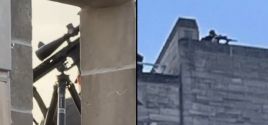World's agricultural legacy gets a safe home: Vault on Arctic isle would protect seedsWashington PostJun. 19, 2006 |
Popular 
Mike Johnson Pushes Debunked Lie That Israeli Babies Were 'Cooked in Ovens' On October 7

'Sniper Seen on Roof Overlooking Pro-Palestine Protest' at Indiana University

'It Has to Be Stopped': Netanyahu Demands Pro-Palestine Protests at U.S. Colleges Be Shut Down

'These Protesters Belong in Jail': Gov. Abbott Cheers Arrest of Pro-Palestine Protesters at UT Austin

Claim Jewish Student Was 'Stabbed In The Eye' by Pro-Palestine Protester Draws Mockery After Video Released
 WASHINGTON - The high-security vault, almost half the length of a football field, will be carved into a mountain on a remote island above the Arctic Circle. If the looming fences, motion detectors and steel airlock doors are not disincentive enough for anyone hoping to breach the facility's concrete interior, the polar bears roaming outside should help. The more than 100 nations that have collectively endorsed the vault's construction say it will be the most secure facility of its kind in the world. Given the stakes, they agree, nothing less would do. Its precious contents? Seeds -- millions and millions of them -- from virtually every variety of food on the planet. Crop seeds are the source of human sustenance, the product of 10,000 years of selective breeding dating to the dawn of agriculture. The "doomsday vault," as some have come to call it, is to be the ultimate backup in the event of a global catastrophe -- the go-to place after an asteroid hit or nuclear or biowarfare holocaust so that, difficult as those times would be, humankind would not have to start again from scratch. Cornerstone for the Fort Knox of seeds Once just a dream -- albeit a dark one, attractive only in comparison to the nightmare that would precede its use -- this planetary larder is about to become a reality. Today, on the barren Norwegian outpost of Svalbard, the prime ministers of five nations and a small throng of other officials will lay the cornerstone for what will be, in effect, the Fort Knox of seeds. "We will have the biological foundation for all of agriculture, which is really saying something," said Cary Fowler, executive secretary of the Global Crop Diversity Trust, the international organization coordinating the vault's creation with the Norwegian government. "It is a stunning achievement, if you think about it, and it would be about as safe as human beings can make it." If progress continues during the short building season this summer and next, the high-tech cavern will start accepting deposits from smaller seed banks and agricultural and scientific organizations by fall 2007 under the terms of an international treaty that took effect two years ago. Then, with a loud clank and the sound of sucking air, the door will close. And the Svalbard International Seed Vault will slip into a subzero slumber -- an insurance policy for human civilization. Scientists estimate there are 2 million varieties of plants used for food and forage today. That includes an astonishing 100,000 varieties of rice, the major staple of the human diet, and more than 1,000 varieties of banana, a nutritious fruit of global importance. Seeds from these crops, which can be smaller than poppy seeds and as large as coconuts, are invaluable repositories of plant DNA. They are the raw material that farmers and researchers rely on to develop more productive and nutritious plants that can cope with climate change, new diseases or pests. Other banks face low germination, destruction About 1,400 seed banks already exist, including large national collections in the United States and China; international ones maintained by the Consultative Group on International Agricultural Research (CGIAR), funded by the World Bank, the Food and Agriculture Organization and the United Nations; and small ones at universities and research labs. Seeds are typically stored at minus 4 degrees Fahrenheit, and are periodically removed and germinated to grow plants, whose fresh seeds are redeposited. But only a few dozen of these banks meet international standards, and even fewer have funding commitments that ensure their long-term maintenance. Indeed, recent surveys have revealed a slow-motion seed bank disaster in the making, with many collections seeing germination rates well below the internationally agreed upon minimum of 85 percent. Worse, some seed banks have recently been destroyed, the victims of war and unrest in Afghanistan, Iraq and Rwanda and a reminder of the fragility of these resources. A backup bank could resupply regional banks like those. Perhaps most important, most of today's seed banks are designed to be working banks -- their contents available to breeders and researchers. That means they are inherently accessible and less than totally secure. "Svalbard is meant to be the bank of last resort," said Pat Mooney, executive director of ETC Group, a Canadian civil society organization focused on food security. "It's where you go if you can't go anywhere else. It's the backup for the whole world." Armageddon mentality The design, described in a recently released feasibility study, bespeaks that Armageddon mentality. First, there is the location: The starkly beautiful and always frozen terrain of Svalbard is, to say the least, off the beaten track. Home mostly to a small community of scientists, coal miners and support staff, it is the northernmost place in the world with scheduled commercial air service. Arctic foxes, reindeer and polar bears stroll the streets. Yet it also has the basic infrastructure that's needed, including a modest network of roads and an electrical generating plant fed by local coal. Plans call for a cavern about 50 yards long, 15 feet wide and 15 feet high. Although it will be built in solid rock, its floor, ceiling and walls will be lined with three-foot-thick layers of high-quality insulating concrete. The door will be opened only once or twice a year, to check contents and add new varieties. Air handling equipment will bring in outdoor air during the winter months, when temperatures hover around minus 30 degrees. Refrigeration units will be available to keep interior temperatures cold during Svalbard's summer, though scientists expect the equipment will rarely be needed and no one will panic if it occasionally breaks down. "Even if you waited a couple of years for the serviceman to show up, it won't really matter," quipped Geoffrey Hawtin, a genetic resource specialist based in England who is serving as a senior adviser to the Global Crop Diversity Trust. "One hears so much about mammoth skeletons and that sort of thing being preserved in the permafrost," Hawtin said. "But this is the first deliberate attempt to use the permafrost to conserve what must be humanity's most important but least-known resource." The Norwegian government is paying for the facility's construction -- an estimated $3 million, with about half of that for the concrete alone, which must be shipped. After that, annual operating expenses are expected to be $200,000 at first, dropping to $100,000 by year three. The trust has established an endowment that so far has $50 million of the $260 million that will be needed to sustain operations without depleting its principal. Contributions have come from about a dozen countries as well as foundations, seed companies and others. International treaty The vault is one of many strategies being implemented in sync with the International Treaty on Plant Genetic Resources for Food and Agriculture, which came into force in 2004 and has been ratified by more than 100 nations. The United States has signed the treaty, but the Senate has not ratified it. At the first meeting of the treaty's governing board last week in Madrid, representatives agreed on crucial legal language that will allow nations to maintain essential patent protections while freely sharing their seeds -- an achievement that participants said will greatly facilitate nations' willingness to donate to the Svalbard vault. Already, Fowler said, CGIAR has promised to contribute samples from its huge network of banks, which hold about 600,000 varieties. And the Department of Agriculture, which oversees the nation's largest seed collection in Fort Collins, Colo., will add holdings that are not in the CGIAR collection, he said. Seeds will be sealed in aluminum foil and stored in batches averaging 500 per package, depending on seed size. The facility is designed to hold 3 million varieties, assuming an average seed size equal to that of a wheat seed. Planners had to consider what would happen if global warming continues unabated. Computer models suggest that no matter what, Svalbard will be one of the coldest places on Earth, Fowler said. And if, as some models predict, global warming shuts down the Gulf Stream and turns the Greenland Sea into a place even more frozen than it is now? It will still be easy enough to keep the door clear of snow, according to the analysis. Hope Shand, research director at ETC Group, which champions farmers' rights, emphasized that banks such as Svalbard's are just one part of the global effort to conserve plant genetic resources. "Ultimately," Shand said, "it's the farmers who grow these crops who are the true custodians of crop diversity." © 2006 The Washington Post Company |



